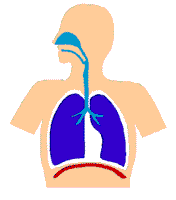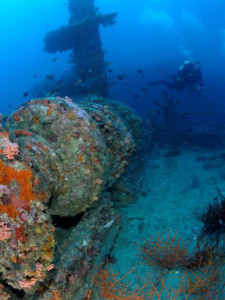My friend Nick called me up the other day and told me about how he was out diving on the Hydro, and had a serious issue with narcosis? The Hydro Atlantic is a beautiful local wreck, 180' to the sand, but only about 130' to the main deck. Nick is a solid diver, and works as a Divemaster and boat crew, and the Hydro is a place he has been to numerous times. Nick went down to a modest depth, tied in, and was stupid narked almost immediately. He did not recover until he came up. He asked, why?
The best definition of narcosis I have ever heard comes from my old friend, Steve. I worked commercial diving with Steve for a lot of years. He was one of the best working divers I ever had the pleasure of being in the water with. We also did a lot of beach diving and spearfishing together, at the Jersey shore. When I went on to do a lot of deeper wreck diving, Steve came to me and asked me to take him to the Doria.
We spent months doing the appropriate workup dives in the lovely New York Mud Hole, he got all his gear dialed in, and we hit the Doria hard. We did a nice orientation dive, swimming around outside the wreck like tourists, but wanted to plan something serious inside, for the next dive. We were diving air, and I was taking Steve to a place I had only been to a time or two, but way, way, way off the beaten track.
So, we dropped down to the wreck at around 180', ducked into the Promenade, swam over to the Double Doors, entered the wreck and went aft to the stairwell. We went into the stairwell, horizontally down two decks, and came out on the Foyer Deck in the Second Class Foyer.
We went across the Foyer, past the revolving door into the Second Class Dining Room, then across the Dining Room to the kitchen, and dropped down to about 230', where we were going to enter the starboard side of the Second Class kitchen, an area that was virtually unexplored, even by me.  I turn to look at Steve, and immediately knew we had a serious problem. He looked like..... Stevie Wonder?? Holy crap!!!!
I turn to look at Steve, and immediately knew we had a serious problem. He looked like..... Stevie Wonder?? Holy crap!!!!
He was all happy bobble-headed, and totally unresponsive to hand signals, light signals, or physical contact. I got behind him, grabbed his manifold, and ascended with him to like 200' where he got a little better and he could at least swim. We exited the wreck and he was somewhat okay, but when we got back on the boat, we had to have a serious talk about the dive.
Of his condition, Steve said, "I was thinking but nothing was happening."
[quote type="center"] I was thinking, but nothing was happening. [/quote]
This is the perfect definition of narcosis.
Have you ever seen That Guy? At one time or another, we have all heard That Guy on the boat, talking about being narked at 100', or 80', or 60' or some other silly depth where it is hard to imagine any diver really being narked!! Yes, I am guilty of the eye roll on this one, sorry. Evidently, the guys at the illustrious Certification Agencies have heard these stories as well, because they invented the ultimate solution...... Recreational Trimix!!!
Back to reality. Okay, so we have That Guy, complaining about being narked at 90', and we can say who believes, That Guy?? We can also kind of understand Steve being toast at 230' deep, deep, deep in the Doria, but how did he get as bad as he was, with all his experience? So, How did Nick get so narked, relatively shallow, on his Hydro dive??
The science types cant' seem to tell us exactly the way Nitrogen Narcosis works, so dive instructors came up with crap like Martini's Law, which states that below 66', every 33' is like drinking a martini!!! This is about as subjective as narcosis really is, but the Law part makes it sound like real science, and it is not.
We know elevated partial pressures of nitrogen has a narcotic effect. More pressure, more narcosis. This effect can be enhanced by rapid descents, colder water, and psychologically challenging situations. But we really don't have much in the way of qualitative, or quantitative analysis to apply to it. How do we compare That Guy at 90', to Stevie Wonder at 230? There is no flashing "Nark 55%" number on my Predator!!
We also know that the same diver making the same dive on different days, does not experience the same level of narcosis? This is Nick. Different divers, same day, same dive can be as different as me and Steve. Is it mental focus, psychological makeup, or practice? What the hell is the Wild Card in nitrogen narcosis????
Enter the villain, Carbon Dioxide.
Forget diving for a minute, let's look at regular old topside medicine. Carbon Dioxide (CO2) Narcosis is a condition that affects individuals who retain, or otherwise have elevated partial pressures of CO2, like people with chronic obstructive lung disease. Serious cases of elevated CO2 bring on CO2 Narcosis which can induce confusion, convulsions, coma, and a host of other bad stuff. CO2 is narcotic, heavily narcotic, like N2 at depth.
 So, Steve and I are on the wreck, it is cold, it is sort of intimidating, and we are swimming, swimming, swimming, and the next thing I know, I am diving with Stevie Wonder!! Nick blows down to only like 135', working at tying in, and he is totally fried. That Guy, is at 90' swimming against the current to the anchor line, and ends up all disoriented and bug eyed.
So, Steve and I are on the wreck, it is cold, it is sort of intimidating, and we are swimming, swimming, swimming, and the next thing I know, I am diving with Stevie Wonder!! Nick blows down to only like 135', working at tying in, and he is totally fried. That Guy, is at 90' swimming against the current to the anchor line, and ends up all disoriented and bug eyed.
I'm not saying that Nitrogen Narcosis did not play any role with these three scenarios; because it did. Also though, IMHO, CO2 narcosis definitely was part of the deal. The combination of elevated partial pressure of N2, combined with the retention of a little CO2 from working, brings on some serious symptoms, far more serious than the effects of N2 alone.
So, Elevated CO2 = Bad. Me personally, I focus on two things to help me better manage narcosis on deeper dives. First, I intentionally minimize my physical exertion, to produce less CO2. Second, I try to breathe more efficiently to keep my CO2 in check.
For me, I try to start out reasonably physically fit, which really means I have some sort of cardio-pulmonary efficiency before I even put a regulator in my mouth. When I jump in the water, I use my arms to pull myself to the anchor line, down to the wreck, and propel myself around on the bottom whenever I can. I drag my motionless legs around like I am a paraplegic, and I move slowly unless something is chasing me.
The body uses oxygen to make energy, with the byproduct being CO2. The small muscles of the arms make much less CO2 than the big oxygen hungry muscles of the legs. Big muscles make big CO2, little muscles little CO2. You cannot kick your fins without using every freaking muscle from your abdomen down to your toes. Stop kicking! Stop kicking, unless you have to!!!!
If you feel yourself getting winded at all, stop and rest. Commercial divers call this "Taking a Vent". If you start breathing hard, the diver stops all activity, and opens both the gas and exhaust valves, venting the helmet until his/her respiratory rate recovers.
 In Hapkido, they practice Don Jon breathing. In Yoga it is called Pranayama. There are all sorts of other names for it, but it is breathing from the abdomen, the diaphragm, not just the chest. Diaphragmatic breathing ventilates the entire lung, not just the upper lobes. Guess what this does really well??? It gets rid of CO2!!!
In Hapkido, they practice Don Jon breathing. In Yoga it is called Pranayama. There are all sorts of other names for it, but it is breathing from the abdomen, the diaphragm, not just the chest. Diaphragmatic breathing ventilates the entire lung, not just the upper lobes. Guess what this does really well??? It gets rid of CO2!!!
Minimizing physical exertion, and breathing efficiently does not happen naturally in divers. You have to work at it to make it happen. By the way, if your waist is a 34", and your 10 year old weight belt is a 30", just go and get a longer weight belt, okay?
Remember, I am not a doctor, but I do have excellent taste in music.
Salud




